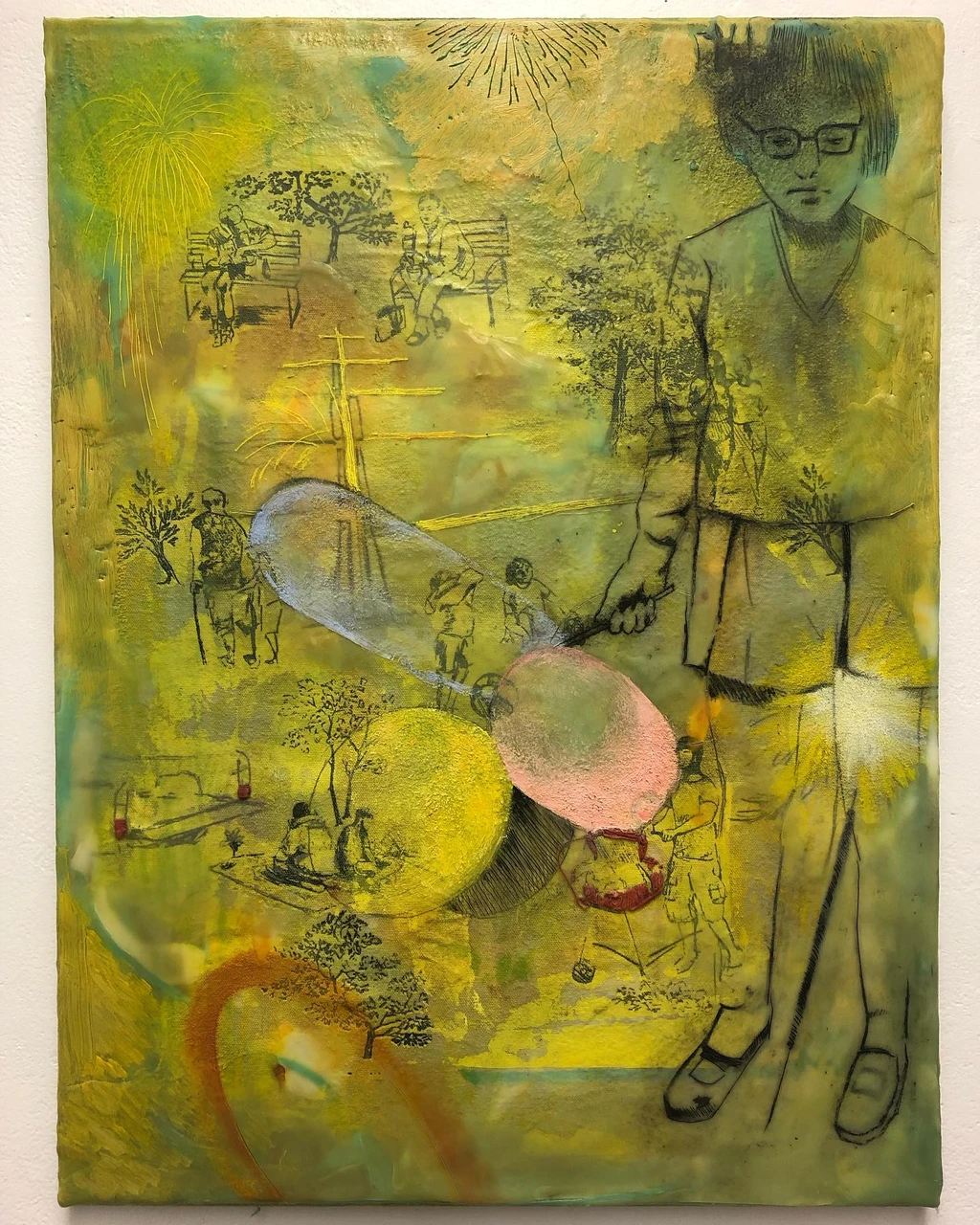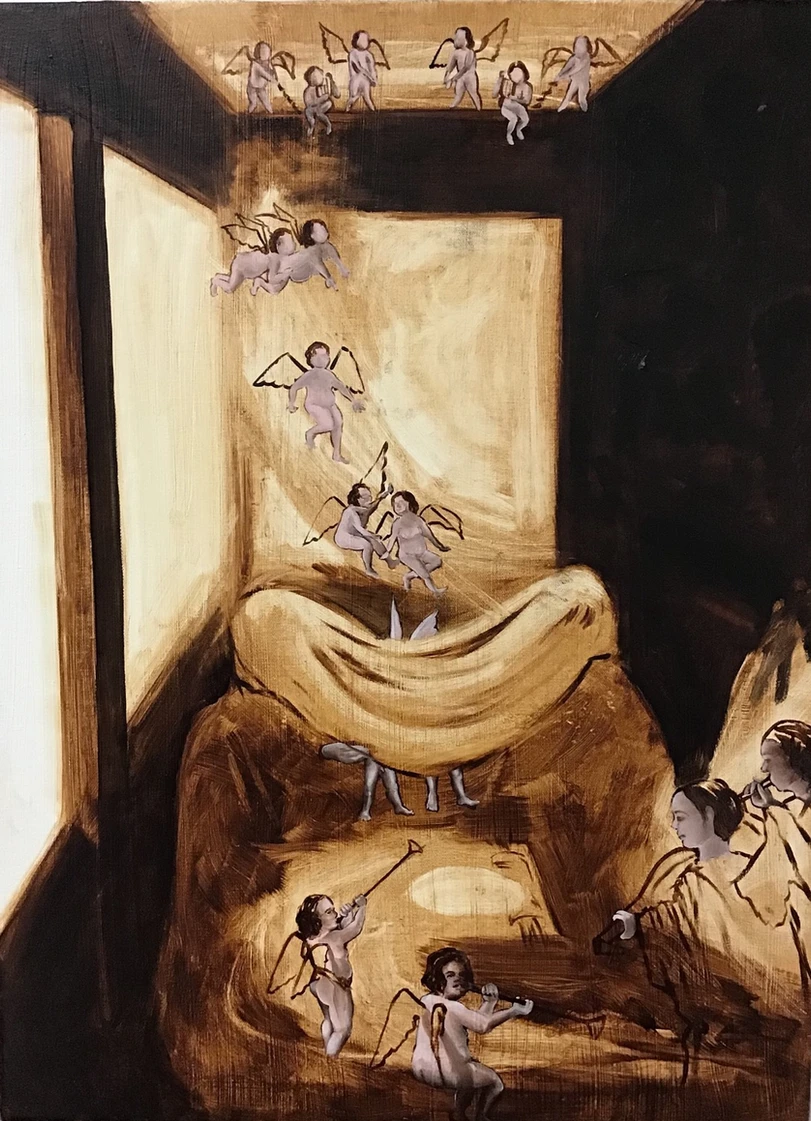
Eight Works
Ruth L. Poor
Volume Two, Issue Three, “Wind,” Visual Art
After Party, 22.5” x 29.5”
acrylic, screenprint, and acrylic medium transfer on paper, mounted on birch pallet
2020
Poor uses collage methods with paint, hand embroidery, and screen printing to create the sometimes juxtaposed, camouflaged, or assimilated Toile de Jouy geographies. Scenes often occupied by human presence are experiments in relationality that explore materials and subjectivity in the context of revisionist histories—focusing on the American/Midwestern/rural fictions that layer and colligate Colonial, white-supremacy mythos, Christian demagogy, or other oppressive means of storytelling. This work combines the pastoral quaintness of the ferme ornée with the theatrics of faith. Created as a reaction to moral architectures, Poor's art sources imagery ranging from 18th-century agrarian landscapes and folk art to theater posters and pop culture. Within the image layers, paint obscures and embroidery re-structures the picture plane while simultaneously re-branding and contextualizing the full image. By utilizing methods seen in decorative arts, I aim to build parallels between bodily/mental interiority and domestic spaces. I view these structures as a macrocosm of the self that holds both the possibilities of mutable appearance/identity and the inevitability of inherited values.
- Ruth Poor, 2022
Snakes and Ladders, 30” x 22.5”
screenprint, hand tatting, ink, acrylic medium transfer on paper
2020
A columnal ash billows up from the right side of Ruth Poor’s Weeds (Jesus Saves), at once arboreal and gaseous. The most rooted of beings is at risk of being carried away by the wind. Hardly a mass, it hovers like trapped smoke. A weak halo of leaves annulates this most unsolid of bodies, giving off puffs of pink and white —almost from the very exertion of maintaining its form. Caught in the ash’s updraft, spectral sleeves of white and rose unreel, leaving the still yard below undisturbed but not un-ruffled. Poor works to visualize not only the American immoveable: the rooted, the rural, the faithful, but also the unleavened layer of hope which the wind subtracts from its surface. It’s this layer which draws from and floats across each of the painting’s landlocked figures. In the left corner of the canvas, four women are tanning. They sit in a balding patch of weeds. Having pasted their dark leaves onto these women’s hands and thighs, Poor lends them the air of being stuck. A sense of silence holds them in place. A huddle with nothing to say to itself, the gaze of these women aims down, up and out at the viewers beyond. Untying her red hair, one woman sighs as the wind tries to carry it higher. Never has the soft ripple of cause and effect felt so tender or so playful. Still, the painting is divided between what is drawn up and what is left behind in the air’s current. Behind her, a great black barn weighs on the horizon. “JESUS SAVES”, or so fades the old reminder cut into its roof. Though a pennant flag arches up and past the barn, dividing the canvas, its colors disappear, seemingly unable to escape the gravitas of this institution. Floating this direction, gathering speed, Poor gives this wind fingers to push through the cuff of its sleeve. Batting at the pennant flag, the wind breaks upon the face of this enormous barn. A scandal, the subject of Ruth Poor’s Weeds is the life and early death of the whirlwind.
- The Editors
Weeds (Jesus Saves) - 18” x 24” x 2.25”,
oil, ink, hand embroidery, acrylic medium transfer, fabric on panel
2020
4th of July, 34” x 29”,
hand embroidery, encaustic, and oil on Toile de Jouy, mounted on panel with pinwheel
2021
Some Tail gate, 30"x21"
hand embroidery, screen print, encaustic, and oil, mounted on board
2021
Sexting in the Circle, 24” x 18” x 2”
ink, screenprint, acrylic, oil, hand embroidery, embroidery hoop, and tatting on panel
2020
Annunciation, 23.5" x 18"
oil on canvas
2018
The New Jerusalem, 51" x 71" x 6"
fabric, screen print, hand embroidery, oil, spray paint, on cotton, stretched on birch bentwood hoop, oak vice and screw
2022
Ruth L. Poor, raised in Indiana, uses their work to dissect memories of the rural midwest and to investigate intersections between identity, power, American history, Christianity, and deviancy. Poor received their MFA from the Painting & Drawing department at the School of the Art Institute of Chicago and completed their B.A. in Studio Art and Religious Studies at Cornell College and DePauw University. They currently reside in Chicago, Illinois, and has shown work at the New York Academy of Art [New York, NY], Zolla/Lieberman Gallery [Chicago, IL], Pinto International Gallery [New York, NY], ADDS DONNA Gallery [Chicago, IL], Manifest Gallery [Cincinnati, OH], Woman Made Gallery [Chicago, IL], and Indiana University [Bloomington, IN].







